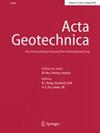Modelling the evolutionary stiffness of granular bentonite mixtures
Abstract
The multimodal and evolutive pore size distribution of granular bentonite mixtures makes it advisable to adopt a triple porosity approach for the macroscopic modelling of their hydromechanical behaviour under different water content conditions. These models must integrate the evolutive effect of compressibility of the megapores between the bentonite grains on the overall stiffness of the mixture. This work proposes a strategy for this integration which, while assuming a constant compressibility of the megaporosity, allows an evolutionary expression for the overall stiffness of the mixture to be obtained. To evaluate the scope of this proposal, the hydration of two mixtures with very different initial packing is analysed. Both analyses start from dry conditions (89 MPa suction) and end in full saturation. Therefore, their analysis requires modelling the behaviour of the granular bentonite mixture for the whole range of structural organisation it can have. It is therefore a very demanding qualification exercise in which, despite the simplicity of the proposed formulation, very satisfactory results have been obtained.

 求助内容:
求助内容: 应助结果提醒方式:
应助结果提醒方式:


